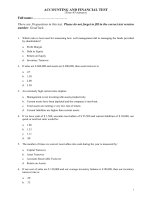4Force, motion, gravitation, and equilibrium test w solutions
Bạn đang xem bản rút gọn của tài liệu. Xem và tải ngay bản đầy đủ của tài liệu tại đây (85.68 KB, 14 trang )
PHYSICS TOPICAL:
Force, Motion, Gravitation and
Equilibrium Test 1
Time: 21 Minutes*
Number of Questions: 16
* The timing restrictions for the science topical tests are optional. If you
are using this test for the sole purpose of content reinforcement, you
may want to disregard the time limit.
MCAT
DIRECTIONS: Most of the questions in the following test
are organized into groups, with a descriptive passage
preceding each group of questions. Study the passage,
then select the single best answer to each question in the
group. Some of the questions are not based on a
descriptive passage; you must also select the best answer
to these questions. If you are unsure of the best answer,
eliminate the choices that you know are incorrect, then
select an answer from the choices that remain. Indicate
your selection by blackening the corresponding circle on
your answer sheet. A periodic table is provided below for
your use with the questions.
PERIODIC TABLE OF THE ELEMENTS
1
H
1.0
2
He
4.0
3
Li
6.9
4
Be
9.0
5
B
10.8
6
C
12.0
7
N
14.0
8
O
16.0
9
F
19.0
10
Ne
20.2
11
Na
23.0
12
Mg
24.3
13
Al
27.0
14
Si
28.1
15
P
31.0
16
S
32.1
17
Cl
35.5
18
Ar
39.9
19
K
39.1
20
Ca
40.1
21
Sc
45.0
22
Ti
47.9
23
V
50.9
24
Cr
52.0
25
Mn
54.9
26
Fe
55.8
27
Co
58.9
28
Ni
58.7
29
Cu
63.5
30
Zn
65.4
31
Ga
69.7
32
Ge
72.6
33
As
74.9
34
Se
79.0
35
Br
79.9
36
Kr
83.8
37
Rb
85.5
38
Sr
87.6
39
Y
88.9
40
Zr
91.2
41
Nb
92.9
42
Mo
95.9
43
Tc
(98)
44
Ru
101.1
45
Rh
102.9
46
Pd
106.4
47
Ag
107.9
48
Cd
112.4
49
In
114.8
50
Sn
118.7
51
Sb
121.8
52
Te
127.6
53
I
126.9
54
Xe
131.3
55
Cs
132.9
56
Ba
137.3
57
La *
138.9
72
Hf
178.5
73
Ta
180.9
74
W
183.9
75
Re
186.2
76
Os
190.2
77
Ir
192.2
78
Pt
195.1
79
Au
197.0
80
Hg
200.6
81
Tl
204.4
82
Pb
207.2
83
Bi
209.0
84
Po
(209)
85
At
(210)
86
Rn
(222)
87
Fr
(223)
88
Ra
226.0
89
Ac †
227.0
104
Rf
(261)
105
Ha
(262)
106
Unh
(263)
107
Uns
(262)
108
Uno
(265)
109
Une
(267)
*
58
Ce
140.1
59
Pr
140.9
60
Nd
144.2
61
Pm
(145)
62
Sm
150.4
63
Eu
152.0
64
Gd
157.3
65
Tb
158.9
66
Dy
162.5
67
Ho
164.9
68
Er
167.3
69
Tm
168.9
70
Yb
173.0
71
Lu
175.0
†
90
Th
232.0
91
Pa
(231)
92
U
238.0
93
Np
(237)
94
Pu
(244)
95
Am
(243)
96
Cm
(247)
97
Bk
(247)
98
Cf
(251)
99
Es
(252)
100
Fm
(257)
101
Md
(258)
102
No
(259)
103
Lr
(260)
GO ON TO THE NEXT PAGE.
2
as developed by
Force, Motion, Gravitation and Equilibrium Test 1
Passage I (Questions 1–5)
An amusement park wishes to build a roller coaster
with a single loop as shown in Figure 1.
1 . The amount of energy lost between point A and point
B is what percentage of the cart’s initial kinetic
energy?
A.
0%
B . 25%
C . 50%
D . 100%
A
C
2 . Examination of Figure 2 reveals that the normal force
on the cart reaches a maximum value of 6Mg. If we
measure the cart’s position in the loop by the angle ϕ ,
shown in Figure 1, at what angle does this maximum
normal force occur?
h
r
ϕ
B
D
A.
B.
C.
D.
Figure 1
For the test run, an empty cart having mass M is
released from point A with an initial velocity v a . The cart
then increases in speed at a non-constant acceleration until
it reaches a velocity of v b at point B. At this point, it is
found to have kinetic energy equal to Mgh, where g is the
acceleration due to gravity and h is the initial height at
point A. The loop portion of the track closely
approximates a perfectly symmetric circle of radius r, and
the distance from point B to point C equals the distance
from point C to point D. When the cart reaches point C, it
is found to have a velocity of v c , which is the minimum
velocity required to keep gravity from pulling it off the
track. It then accelerates down the back side of the loop to
point D, where it reaches its final velocity, vd.
Figure 2 shows a graph of the magnitude of the
normal force N that the track exerts on the cart as a
function of distance s between points B and D. In the
graph, the energy lost due to friction has not been included.
If the effects of friction were included in Figure 2, the
normal force on the cart in the loop would:
A.
B.
C.
D.
remain the same everywhere in the loop.
increase everywhere in the loop.
decrease everywhere in the loop.
increase in some places and decrease in other
places.
4 . According to Figure 2, what is the correct value for the
cart’s kinetic energy at point C?
A.
B.
C.
D.
Mgr/2
Mgr
3Mgr/2
5Mgr/2
5 . When passengers are riding in the cart, its mass
approximately doubles. The minimum velocity v c at
point C will then:
6 Mg
A.
B.
C.
D.
N
Mg
3
ϕ = 0°
ϕ = 30°
ϕ = 180°
ϕ = 210°
B
C
be cut in half.
remain the same.
be doubled.
be quadrupled.
D
s
Figure 2
GO ON TO THE NEXT PAGE.
KAPLAN
3
MCAT
where G is the universal gravitational constant, m is the
mass of the object, M e is the mass of the Earth, and R is
the distance of the object from the center of the Earth. One
result of this analysis is that Kepler’s laws can be derived
for satellites orbiting the Earth. These laws were originally
discovered by Johannes Kepler (1571–1630) based on
observations of the motion of the planets about the Sun.
They are as follows:
I. All satellites move in elliptical orbits with the
Earth at one focus.
II. A line that connects a satellite to the center of the
Earth sweeps out equal areas in equal times.
A . double the time that it takes to move through θ.
B . half the time that it takes to move through θ.
C . the square of the time that it takes to move
through θ.
D . equal to the time that it takes to move through θ.
8 . Which of the following graphs represents how the
magnitude of acceleration of a falling object changes
with the distance through which it has fallen, if no
approximation is made with regard to the distance?
A.
III. The square of the period of any satellite is
proportional to the cube of the semimajor axis of
its orbit.
height fallen
height fallen
B.
D.
acceleration
For objects near the surface of the Earth, a great
simplification in the mathematics occurs by approximating
the gravitational force to be a constant. Let R = R e + h,
where Re is the radius of the Earth, and h is the distance of
the object from the surface of the Earth. The gravitational
force can now be written as:
C.
acceleration
F = GmM e/R2
F = GmMe/(Re + h)2,
acceleration
The general motion of a massive object under the
influence of the Earth’s gravitational force can be solved in
closed form using Newton’s second law. The gravitational
force is given by:
7 . Consider a satellite in circular orbit around the Earth at
a distance R from the Earth’s center. The area that the
satellite sweeps out as it moves through an angle θ is
given by A = R2θ/2. Kepler’s second law implies that
the time that it takes for the satellite to move through
2θ is:
acceleration
Passage II (Questions 6–11)
height fallen
height fallen
which is approximately equal to GmMe/Re2 when h <
defined to be the free-fall acceleration. (Note: The universal
gravitational constant is G = 6.67 × 10–11 N•m2/kg2. The
mass of the Earth is Me = 5.98 × 1024 kg, and its radius is
R e = 6.37 × 106 m.)
9 . Which of the following expressions shows how the
acceleration due to gravity depends on the height of an
object above the surface of the Earth?
6 . Two balls of unequal mass are dropped from the same
height. If the gravitational force is assumed to be
constant, then the theory predicts that they will hit the
Earth’s surface at the same time. If the actual force is
used instead, then the theory predicts:
1 0 . A satellite of mass m is in circular orbit around the
Earth at a distance R from the Earth’s center. If R is
increased by a factor of 4, then the period of the orbit
will be: (Note: The semimajor axis of a circle equals
its radius.)
A.
B.
C.
D.
4
that the ball with the larger mass will hit first.
that the ball with the smaller mass will hit first.
that they will hit at the same time.
nothing, since the equation of motion cannot be
solved without the constant force approximation.
A.
B.
C.
D.
A.
B.
C.
D.
G(Re + h)
2G(Re + h)2
GM e/(Re + h)
GMe/(Re + h)2
unchanged.
increased by a factor of 4.
increased by a factor of 8.
increased by a factor of 64.
as developed by
Force, Motion, Gravitation and Equilibrium Test 1
GO ON TO THE NEXT PAGE.
1 1 . The amount of energy needed to move a rocket having
mass m from the surface of the Earth to a distance R
from the Earth’s center is E = GmM e(1/Re – 1/R).
What is the minimum velocity the rocket must have
in order to completely escape the Earth’s gravitational
field?
A.
B.
C.
D.
KAPLAN
(2Gm/Re)1/2
(2GMe/Re)1/2
(2gh)l/2
(2mGRe)l/2
5
MCAT
Questions 12 through 16 are NOT
based on a descriptive passage.
1 2 . A 1-kg aluminum sphere and a 3-kg brass sphere, both
having the same diameter, are allowed to fall freely
from the same height above the ground. Neglecting air
resistant and assuming both spheres are released at the
same instant, they will reach the ground at:
A.
B.
C.
D.
the same time but with different speeds.
the same time and with the same speed.
different times and with different speeds.
different times but with the same speed.
1 3 . A 20-kg boy, starting from rest, slides down a slide
that makes a 30° angle with the ground. The
coefficient of kinetic friction between the boy and the
slide is 0.20. What is the magnitude of the boy’s
acceleration as he slides? (Note: Assume that the
acceleration due to gravity, g, equals 10 m/s 2. The
cosine of 30° is 0.866, and the sine of 30° is 0.5.)
A.
B.
C.
D.
1.7
3.3
5.0
7.7
m/s2
m/s2
m/s2
m/s2
1 5 . A massless rod of 4 meters is placed on a fulcrum as
shown in the diagram below. An object of mass m is
attached to one end and an object of mass 2m is
attached to the other end. Where must the fulcrum be
placed for the system to remain in equilibrium?
2m
A.
B.
C.
D.
m
1.33 meters from the left
1.50 meters from the left
2.33 meters from the left
2.67 meters from the left
1 6 . A 10 kg mass on a horizontal table top is being
swung counterclockwise in a circular path and is
slowed down by a frictional force. The net force on the
mass when it lies in the position shown, points
toward:
B
10 kg
A
1 4 . A car traveling at 25 m/s requires 10 seconds to come
to rest, with an average braking force of
2,000 N. What is the mass of the car?
A . 200 kg
B.
400 kg
C . 800 kg
D . 1,000 kg
D
C
A.
B.
C.
D.
GO ON TO THE NEXT PAGE.
6
v
A
B
C
D
END OF TEST
as developed by
Force, Motion, Gravitation and Equilibrium Test 1
THE ANSWER KEY IS ON THE NEXT PAGE
KAPLAN
7
MCAT
ANSWER KEY:
1. D
6. C
2. A
7. A
3. C
8. A
4. A
9. D
5. B
10. C
8
11.
12.
13.
14.
15.
B
B
B
C
A
16. D
as developed by
Force, Motion, Gravitation and Equilibrium Test 1
EXPLANATIONS
Passage I (Questions 1—5)
One should recognize that it would not be efficient to try to memorize all of the information presented in the passage
as one is reading it for the first time. Instead, it is better to concentrate on the physical content of the situation. First of all, we
suspect that energy conservation is an important tool since the acceleration is not constant: most of the kinetics equations
would therefore not apply. We have not been given explicit information about friction, but we know from energy conservation
and the information given about points A and B in Figure 1 that it must be present. We are also told at the end of the passage
that friction is not included in the graph of Figure 2. That is however something we will need to take into account.
1.
D
1
2
Mva2. In addition to this, however, the cart also has gravitational potential energy equal to Mgh. The sum of the two is its total
initial energy. At point B, the cart has no gravitational potential energy but only kinetic energy. We are not given the velocity
of the cart at that point, but are told that the kinetic energy at B (and therefore the total energy at B) is equal to Mgh: the initial
1
potential energy of the cart. Therefore the amount of energy that has been lost to friction is
Mv a2, or 100% of the initial
2
kinetic energy.
In the passage we are told that at point A, the cart has an initial velocity of va. Its initial kinetic energy is therefore
2.
A
Choice C, 180°, can be eliminated immediately since that corresponds to point C, at which the normal force is zero
according to Figure 2. Within the loop the cart is undergoing circular motion (not uniform since the velocity is changing). At
any point the instantaneous centripetal acceleration is v2/r, where v is the velocity at that point. This acceleration needs to be
provided by a net force perpendicular to the track. The normal force, by definition, is perpendicular to the track, but there will
also be a component of gravity that acts in the same or opposite direction. The component of gravity pointing in the opposite
direction as the normal force is given by Mgcosϕ:
normal force
j
Mgcosj
Mg
Thus the equation is:
N – Mgcosϕ = M
N=M(
v2
r
v2
+ gcosϕ)
r
Notice that at the bottom half of the loop, ϕ is either between 0° and 90°, or between 270° and 360°, and so cosϕ
would be positive, leading to a larger value for the normal force: the normal force needs to be greater because it needs to
counteract gravity and provide the centripetal acceleration. Conversely, at the top half of the loop, ϕ is between 90° and 270°,
and cosϕ is negative, leading to a smaller value for the normal force. Physically, there is a component of gravity that is parallel
KAPLAN
9
MCAT
(rather than antiparallel) to the normal force and therefore it “reduces the burden” of the normal force to provide the centripetal
acceleration, allowing it to have a smaller value.
Going back to the question, the value of cosϕ is at a maximum when ϕ = 0°. At that same point, v is also at a
maximum since the cart loses kinetic energy as it rises in the loop. Thus, ϕ = 0° is the point at which the normal force is at a
maximum.
3.
C
Friction between the track and the cart would cause the cart to slow down. This has the effect of lowering the value of
v in the right-hand side of the equation given above (in the explanation to #2) for the magnitude of the normal force. The
equation is otherwise unaffected since the friction force is always directed opposite in direction to that of travel, and is thus
perpendicular to the normal force: the friction force does not enter into the equation directly since it has no component in the
normal direction.
4.
A
According to Figure 2, the normal force is zero at point C. The centripetal acceleration is therefore provided by the
gravitational force entirely. At point C, the direction perpendicular to the track is parallel to gravity, which means that all of
gravity (rather than just a component) is providing the centripetal acceleration:
v c2
r
2
vc = gr
Mg = M
where vc is the velocity of the cart at point C, and is the minimum velocity required for the cart to stay on the track rather than
1
fall off. The kinetic energy at that point is Mvc2. Substituting in the relation we just obtained, we have:
2
K.E. =
1
Mgr.
2
5.
B
The minimum velocity vc is always that corresponding to a zero normal force. Its value can be determined using the
equations given above in the explanation to #4. As you can see, it is unaffected by the mass since M cancels out. Again,
friction force does not appear explicitly since it is perpendicular to the normal direction.
Passage II (Questions 6—11)
6.
C
The question asks us to determine how our more exact theory of gravity would predict the relative times it will take for
two balls of unequal mass dropped from the same height to reach the ground. The approximate theory neglected the difference in
height of various objects since it was small compared to the radius of the Earth; the approximation lies not in the masses
involved. In the scenario given, the balls are dropped from the same height, and thus whatever correction is made to the falling
time of one will also be made to the other. The two will therefore still hit the Earth at the same time.
You may want to note, for example, that in the usual approximate case, F = mg = ma. A larger mass would mean a
larger gravitational force, but does not mean a larger acceleration since the m’s cancel. What we have here is a more accurate
expression for g: one that is not constant but varies with distance. The mass, however, still does not affect the acceleration.
7.
A
A close reading of Kepler’s laws is necessary. These laws, originally derived for planets orbiting around a star, applies
also to satellites revolving around the Earth. The second statement in the laws, when applied to satellites, tells us that a line
connecting the satellite to the center of the Earth sweeps out equal areas in equal times. This means that if the satellite sweeps
out an area A in time t, it will sweep out an area 2A in time 2t, etc.
In the question stem, we are told that the satellite travels in a circular orbit. We are also given a formula relating the
area and the angle θ that the satellite sweeps out: the area is directly proportional to θ. Therefore, if the satellite sweeps out an
angle 2θ, the area swept out will be 2A. The time is therefore twice that of sweeping out θ, from the reasoning in the paragraph
above.
10
as developed by
Force, Motion, Gravitation and Equilibrium Test 1
8.
A
We are used to thinking of acceleration due to gravity as being constant (9.8 m/s2), and so may have been tempted to
choose choice D. The passage however points out that this is only an approximation. In reality, the acceleration is changing
because the gravitational force on an object is greater as it gets closer and closer to the Earth. The force is inversely proportional
to the square of the distance; and the acceleration is directly proportional to the force (ma = F g). As the distance between the
object and the Earth gets smaller and smaller, then, the force and the acceleration is getting larger and larger.
We then need to decide between choices A and B. Would the acceleration increase linearly with time, as in B, or
nonlinearly, as in A? The gravitational force depends on the inverse distance squared. This would lead us to expect that the
increase would be nonlinear.
9.
D
The passage indicates that the exact gravitational force is:
GMem
(R e + h) 2
F=
This is the force that provides the acceleration as the object falls, i.e. the expression is also equal to ma. Solving for
the acceleration, then, one notices that the mass of the object, m, cancels to result in:
a=
GMe
(R e + h) 2
Notice that in the case of the approximate theory, a =
GMe
and this is the constant g with which we are so familiar.
R e2
10.
C
This question requires us to find a relationship between the period and the radius of orbit for a satellite. Kepler’s third
law is precisely what we need: It says that the square of the period of a satellite is proportional to the cube of the semimajor
axis of its orbit. The term “semimajor axis” is used in reference to an elliptical orbit, but we need not know its exact definition
since, in the question stem, we are told that this is equal to the radius of the circle in the case of a circular orbit. The
relationship is therefore:
T2 = kR3
where T is the period, or the time it takes for the satellite to complete one round trip, R is the radius (or semimajor axis), and k
is the proportionality constant. If the radius increased by a factor of four, i.e. R’ = 4R, then, the new period T’ would satisfy:
(T’)2 = k(4R)3
= 64kR3
= 64 T2
= (8T)2
The last two lines of the equation tell us that the new period squared is 64 times the old period squared, or equivalently,
that the new period is eight times the old period.
11.
B
This question can be handled by an energy conservation approach. The question stem gives us the energy required to
move a rocket having mass m from the surface of the Earth to a distance R from the Earth’s center. In order to find the energy
required to escape the Earth’s gravitational field completely, we need to move the rocket from the surface of the Earth to an
infinite distance from the Earth’s center. Setting R equal to infinity and using the fact that 1/ = 0, we find that the energy
needed to escape the Earth’s gravitational field is:
E = GmMe (
KAPLAN
GmMe
1
1
– )=
Re
Re
11
MCAT
Where does this energy come from? The initial kinetic energy of the rocket. If the initial kinetic energy is greater than
this amount, it will be able to escape the Earth’s gravitational field, and the difference will be the leftover kinetic energy. The
minimum velocity the rocket must have therefore corresponds to a kinetic energy that is just equal to the expression above:
GmMe
1
mvmin2 =
2
Re
Canceling m from both sides and solving for vmin gives:
2GMe
Re
vmin =
Independent Questions (Questions 12–16)
12.
B
Even though the force of gravity is dependent on the mass of the dropped object, it does not enter into the acceleration
since the mass cancels when one equates the gravitational force to ma. In other words, all objects, regardless of their mass, are
accelerated towards the Earth at the same rate (assuming there is no air resistance, as we are instructed to do so in the stem). If
the initial height of the object is small compared to the radius of the Earth, this rate is a constant g, equal to 9.8 m/s2. The time
it takes for the spheres to fall can be determined from the kinetics equation:
h = v0 t +
1 2
gt
2
where h is the initial height of the object, and v 0 the initial velocity. This is a quadratic equation in t, but if the spheres are
2h
.
g
From kinetics equations, one can also determine the speed of the sphere right before it hits the ground. All these
calculations are obviously not necessary for this question; the most important thing is to realize that the acceleration
experienced by the two spheres would be equal, which in turn implies that the time taken and the final speed are the same for the
two as well.
dropped (rather than thrown down), the initial velocity is zero and thus the time for each sphere to reach the ground is
13.
B
This question is a straightforward application of Newton’s second law which states that the vector sum of all the forces
acting on a body is equal to its mass times its acceleration vector. In this case there are three forces acting on the boy:
friction
normal force
mg
30°
The first is his weight mg acting in the vertical direction downwards. The second is the normal force acting
perpendicular to the slide upwards. The third is the force of friction parallel to the slide but opposite to the direction of motion.
What is the magnitude of the acceleration vector? The boy accelerates downward along the surface of the slide. The acceleration
vector is therefore parallel to the slide. Its magnitude is the difference between the magnitude of the component of gravity
parallel to the slide and the magnitude of the friction force, divided by the mass of the boy. The magnitude of the friction force
is dependent on the normal force N via the equation:
Ffr = µN
12
as developed by
Force, Motion, Gravitation and Equilibrium Test 1
where µ is the coefficient of kinetic friction. The magnitude of the normal force N is in turn dependent on the weight and the
angle of the slide: it must exactly balance the component of gravity perpendicular to the slide; otherwise the boy would
accelerate in that direction. I.e.:
N = mg cos30°
Ffr = µN = µmg cos30°
The component of gravity parallel to the slide is mg sin30°, and so the acceleration a satisfies:
mg sin30° – µmg cos30° = ma
m cancels on both sides since it appears in all three terms. Approximating g by 10 m/s2 and substituting in the values
for the coefficient of friction, we get:
10 sin30° – 0.2 × 10 cos30° = a
a = 10 × 0.5 – 0.2 × 10 × 0.866 = 5 – 1.74 = 3.26 m/s2
Choice A is the deceleration caused by friction. Choice C is the answer obtained if friction were ignored. If you
reversed the sine and the cosine, you would have gotten choice D. It is important to understand the trigonometry involved:
mg
x
y
30°
The angle between the vertically downward force and the component perpendicular to the plane (between mg and x in
the diagram above) is always the same as the angle that the inclined plane makes with the horizontal, in this case 30°. The
lengths x and y can then be found by simple trigonometry (make sure you can rotate the triangle in your mind to see how one
obtains the diagram below):
mg
y
30°
x
y
= sin30°
mg
x
= cos30°
mg
14.
or
y = mg sin30°
or
x = mg cos30°
C
The car goes from an initial velocity of 25 m/s to 0 m/s in 10 s. The average deceleration can be found by:
a=
v
t
=
(0 – 25)
= –2.5 m/s2
10
The mass of the car can then be determined by using Newton’s second law F = ma, where F in this case is the average
force, equal to 2000 N.
m=
KAPLAN
F 2000
=
= 800 kg
a
2.5
13
MCAT
Alternatively, we know that the change in momentum is equal to the impulse:
p = (mv) = mv = Ft
Ft
2000 (10)
m=
=
= 800 kg
v
25
15.
A
For the rod to remain in equilibrium, the torque acting in the clockwise direction must equal the torque acting in the
counterclockwise direction. Torque is equal to force × (distance from fulcrum). In this case the force is the weight of the objects.
x
4–x
F = mg
F = 2mg
If we let the distance between the fulcrum and the left end of the rod be x meters, then the torque caused by the mass on
the left is 2mgx in the counterclockwise direction. The torque generated by the mass on the right will then be mg(4 – x) in the
clockwise direction. Setting the two torques equal and solving for x:
2mgx = mg (4 – x)
2x = 4 – x
3x = 4
4
x = = 1.33 m
3
16.
D
For any object traveling in a circle, there is an acceleration directed towards the center of the circle that captures the fact
that the object is constantly changing direction. From Newton’s second law, there must be a force (or a component) that points
towards the center of the circle since the force and acceleration vectors are parallel. In the case of uniform circular motion
(constant speed), then, the net force and the net acceleration would both point to the center. In this question, however, in
addition to this centripetal acceleration, we also have a change in speed brought about by friction. Friction force acts in a
direction opposite to the tangential motion of the object. Since the block is moving counterclockwise, the friction force must
then act in a clockwise direction. When the object is in the position shown in the diagram, the friction force points downward,
parallel to C. This, added vectorially to the force sustaining centripetal acceleration, would give a vector that points in the same
direction as D. This can be seen using the pictorial method of vector addition:
centripetal force
friction force
14
vector sum
as developed by









